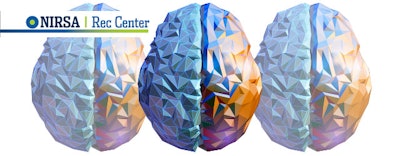
While campus recreation professionals have included concussion as part of their risk management strategy for years, they nevertheless received a wakeup call in 2016 when a large European re-insurance company indicated to its Canadian market that the rise in concussions-related lawsuits had them considering the exclusion of head trauma from its liability coverage for higher education institutions.
All 50 states have some form of concussion legislation in place
22%of NIRSA member institutions have no athletic training services or coverage in recreation programs (n=89)
64%of NIRSA member institutions are educating staff or participants on head injuries at least annually (n=87)
70%of existing concussion education programs address removal from play (n=80)
Source: 2017 NIRSA Concussion Advisory Council survey; n=sample size of self-reporting institutions |
"That created some panic in Canada and concern that it also could happen in the United States," says Lexi Chaput, senior assistant director for sport programs and development at the University of Michigan, as well as chair of NIRSA's Concussion Advisory Council — established in 2017 to raise awareness, promote education, evaluate diagnostic technologies and advocate for campus recreation within the insurance marketplace. "We saw a need for more work, more resources, and more time and energy to be spent on this issue."
"The council has moved concussions up on people's agenda," adds Wallace Eddy, associate director of risk management and assessment for University Recreation and Wellness at the University of Maryland and a member of the Concussion Advisory Council.
In less than two years, the council's seven members have taken up such topics as return-to-play protocol, the pros and cons of concussion assessment tools, concussions and the role of personal responsibility, and the importance of forging strong partnerships both on and off campus to support the safety of recreation program participants.
Members also have compiled several concussion protocol case studies from recreation departments at the University of Nebraska-Lincoln, Oklahoma State University, Elon University, and the University of California, Davis, among others.
While the re-insurance businesses have not yet followed through on nixing head trauma coverage, at least one large insurance company now excludes any neurological injury from all liability insurance policies for sports and recreation organizations in the United States.
"Concussions are a new threat, because key players in the insurance market who are worried about potential future class-action lawsuits are examining how they issue negligence liability insurance policies that cover concussions to colleges and universities," Ian McGregor, president of risk-assessment provider Ian McGregor & Associates and a longtime NIRSA member, said last year when his company introduced the SportRisk concussions training package developed specifically for campus recreation.
The training package, available to NIRSA member schools for a discounted annual subscription fee, includes two separate modules: one that allows recreation department leaders to educate their staff, coaches and participants with overview information and awareness training, and one that offers more advanced recognition and response training for individuals — such as student referees and safety officers — responsible for recognizing potential concussions and responding appropriately.
"I think that more insurance companies will probably follow suit," Chaput says. "The exclusion may be worded differently, but it's becoming more and more difficult to find insurance that covers head injuries."
Not just 'fun stuff'
The threat of reduced insurance coverage essentially demands that campus recreation professionals step up their recognition and treatment of concussions for all participants. It's easy for an intramural basketball player who takes a tumble and hits his head on the court to sit on the sidelines for a few minutes and then jump back into the game — unless a teammate or referee cautions him or her against doing so. That's why education and medical attention are so important.
"People think recreation is all about the fun stuff," Eddy says. "But we have students who do serious physical activities, and we need to address what we're doing to keep them safe."
One of the Concussion Advisory Council's first major tasks was conducting a survey of NIRSA members. The survey found that 22 percent of responding member institutions had no athletic training services or coverage in their campus recreation programs. Several programs also were missing such key elements as concussion education and protocols.
"We saw that there were opportunities for enhancements across the board, and that our field does not have a consistent standard," says Chaput, who adds that a lack of resources prevents Michigan from hiring athletic trainers for campus rec. "There's such disparity when you look at what campuses are able to do, because the available resources vary so widely from school to school. We need to provide NIRSA institutions with concussion management tools and options that are attainable."
Michigan focuses its efforts on concussion education and accountability. All club sports coaches and safety officers complete a required training course for which they receive a certificate of completion and sign an agreement — adapted from a Michigan Athletics resource — committing to removing team members from play immediately following a head injury. All club sports participants, meanwhile, must sign an agreement that includes a waiver and proof of required medical insurance, as well as watch a concussion education video. Staff members also recommend that injured students seek medical attention and clearance before returning to play.
While Maryland emphasizes education too, campus recreation officials there have partnered with the orthopedics department at the university's School of Medicine to provide two full-time certified athletic trainers at all high-risk practices and games, plus some moderate-risk games. The athletic trainers also staff a training room every weekday and for about 20 hours per week they tend to all walk-in and intramural/club sports injuries. The recreation department contracts for that service, which costs about $172,000 per year, according to Eddy.
"Parents send their students to college expecting that we'll take care of them," he says. "This is something we must do."
Do something
Do something. That's the simple advice Eddy and Chaput offer. Consult with your campus risk management office about available options, or partner with organizations on campus and off. Medical students might be looking for clinical hours that can be fulfilled in the recreation department.
Even digital signage or posters that educate students on the dangers of concussions and their long-term impact — or providing links to concussion tools and resources on a campus recreation website — can make a difference.
Additionally, one of the Concussion Advisory Council's latest efforts is a "next steps" survey created to seek feedback from NIRSA members about what concussion education and management resources are needed now.
"Regardless of the new developments in insurance, don't only look at this from a legal obligation standpoint," Chaput says. "Look at it also from our commitment to the overall wellbeing of our community. The hope is that we positively impact our colleagues and help them find ways to keep their spaces and participants safe."
This article originally appeared in the June 2019 issue of Athletic Business with the title "Concussion management top of mind for campus rec." Athletic Business is a free magazine for professionals in the athletic, fitness and recreation industry. Click here to subscribe.





































